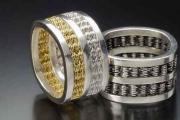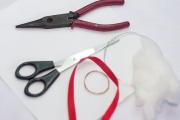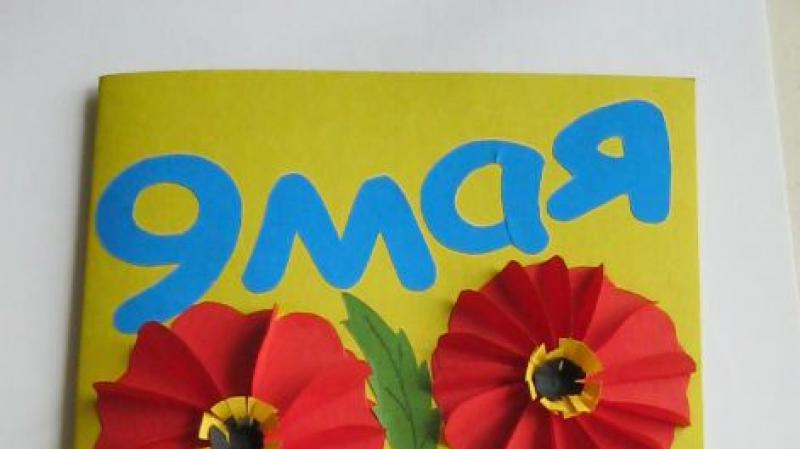How to properly extend nails at home. Starter kit with the necessary materials for gel nail extension
One of the modern ways to get a reliable manicure is to extend nails with gel on forms. Following the instructions step by step, you can carry out nail extension at home. The gel allows you to model the shape and length of nails, while maintaining the aesthetics of the manicure for two to three weeks.
Mandatory set of tools:
Mandatory set of materials:
- Antiseptic for pretreatment of the nail and adjacent skin.
- Cuticle softener.
- Composition for disinfection, degreasing, dehydration. You can use separate formulations, but it is better to purchase a specialized spray or 3-in-1 liquid preparation that performs all three functions.
- Primer (or other adhesive composition) - to ensure adhesion of the nail plate to the gel.
- Degreaser that removes the sticky layer.
- Base gel coat. The gel can be one-, two- or three-phase.
- Colored gel coatings.
- A high gloss gel finish.
Types of gel for nail extension
For successful nail extension, it is necessary to ensure strong adhesion of the polymer to the nail plate, correct the shape of the nail and give it shine and smoothness. According to the process technology, gels are divided into one-, two- and three-phase - depending on the number of technological stages and compositions required for work.
There are a large number of gels from different manufacturers on the market.
Experienced craftsmen advise choosing products from the following brands:

There are other brands on the market as well.
What is the difference between single-phase and three-phase gel
The sequence of step-by-step actions for building nails with gel on forms differs depending on which technology is used: single-phase, two-phase or three-phase.
Differences:
- Gel composition used for single-phase extension, performs all the necessary functions: guarantees adhesion to the nail base, allows you to simulate the required shape of the nail, ensures smoothness and shine of the coating. This technology is very convenient for beginners, because the easiest to use: only one type of gel is required, which is applied in one step and fixed in one session of irradiation with an ultraviolet lamp.
- Two-phase technology requires the use of two types of gel. One of them provides connection and modeling, and the other is protective, ensuring smoothness and strength of the nail. Accordingly, two coats and two curing sessions under a UV lamp are required.
- Work on three-phase technology the most time consuming. Three compounds are used: for adhesion, for modeling, for protection. Each layer is applied and illuminated with a lamp separately. This method requires the master to have work experience and qualifications. Professionals prefer this particular technology because of the high quality of the modeling.
Preparing nails
Before building, the nail needs high-quality preliminary preparation:

The nail plate is ready for extension.
How to fit the shape to the nail
A mold is a marked template made of metal, Teflon, and other materials. Durable reusable forms require thorough disinfection after use, so disposable forms made of paper, thin plastic, and foil are often used. The form can be fixed at the top or bottom of the nail.
Installation and fitting of the shape is a very important stage on which the quality of the extended nail depends.
When using solid forms, it is necessary to select the size of the nail so that it fits perfectly to the nail plate. The form is bent with light pressure and put on the nail through the provided hole. After matching the shape with the "smile line", it is securely attached to the finger.
Disposable soft forms require additional adjustment. They make it possible to fit the stencil to the outline of a specific nail plate. This is especially useful when processing nails with irregular shapes. If the forms are too soft, then experienced craftsmen it is advised to glue two pieces together. 
The disposable template is removed from the substrate, the oval marked by perforation is extruded and glued with back side shape, providing additional rigidity. The bottom edges are torn along the perforated line, the shape folds slightly and slides over the finger. There is a center line for orientation on the form.
Before the final fixation on the finger, the shape is given the desired slope - it should continue the line of the nail, without deviating up or down. If, in this case, gaps are formed between the surface of the nail and the mold, the cutout of the mold is corrected with nail scissors. The coincidence of the shape with the root arch must be perfect, otherwise the gel will flow into the resulting gaps.
After fitting, the “ears” are carefully glued to fix the shape on the nail. The bottom edges of the mold are glued to the finger. The shape is adjusted individually for each nail.
Stages of nail extension with single-phase gel on forms
The single-phase gel, due to its ease of use, is optimal for those who are just learning the art of nail extension. Novice craftsmen should build each finger separately.
After gaining practical skills, it is important to observe the order of extension: first 4 nails (except for the thumb) of one hand, then 4 nails of the other, the nails on the thumbs are processed last, otherwise the gel will drain from them due to the position at an angle. 
Build-up step by step with gel on forms:
- Preliminary preparation of nails:
- antiseptic treatment;
- hygienic manicure;
- filing the edge of the nail and nail surface;
- cleaning from nail dust;
- application of dehydrator and primer.
- Installation and fitting of the form.
- Applying the first gel layer. The layer is made thin by spreading the gel with a brush over the entire area of the nail. On the first third of the nail at the base - the cuticle area - the gel is applied in a thin layer. On the stress zone (the rest of the nail area, the line of the nail and the mold junction, one third of the mold), the layer thickens slightly, because this is where the bulk of the load falls. Towards the edge of the simulated nail, the layer becomes thinner again. The layer is polymerized - under a UV lamp for 2 minutes, under a LED - 1 minute.
- Application of the second gel layer. A drop of gel is applied with a brush in the middle and gently spread over the surface. Then you need to hold your fingers horizontally for half a minute so that the gel is equally distributed over the surface of the first layer. The polymerization conditions are the same as for the first layer.
- Removing the sticky layer- produced with a lint-free napkin.
- Removing the stencil.
- Surface grinding and adjusting the edge of the created nail.
- If necessary - applying a decorative coating.
How to work with three-phase gel - step by step instructions
Building up step-by-step with a three-phase gel on forms requires a certain experience and qualifications from the master.
Sequencing:

Building lesson: French on forms - in stages with a photo
Classic French manicure (French) is a plain, discreet background (flesh or pinkish tint) and a clearly drawn white "smile line" along the edge of the nail. The appearance of extended nails led to a new round of popularity of the jacket, which looks especially impressive on nails of the correct geometric shape.
When creating a jacket using forms, it is laid out with a gel of the selected color.
 Extension gel step-by-step on forms is performed for any nail shape.
Extension gel step-by-step on forms is performed for any nail shape. Stages of performing a service jacket on forms:
- Preliminary preparation of nails.
- Installation and fitting of the form. The edge of the mold is placed under the nail, the other edge is fixed on the finger.
- Application of a layer of base gel. To give it a matte finish, you can blot it with a napkin.
- The gel of the chosen shade (pinkish, flesh-colored) forms the nail - up to the border of the future "smile". The "smile line" is laid out very carefully. The surface must be perfectly flat.
- Gel white using a brush, a smile contour is formed, the gel is applied close to the main color. The layer is polymerized - under a UV lamp - 2 min, under an LED - 1 min.
- Removing the form.
- Grinding the surface and adjusting the edge of the created nail, removing the sawn-off particles.
- Application of a transparent layer for protection and shine.
You can create a French manicure without using white gel. Then a "smile" is drawn on the formed nail with a white acrylic paint, and the nail is covered with a protective layer of transparent gel, which is polymerized according to the technology.
Extension with gel-jelly
Gel-jelly is one of the latest developments in the field of nail design. The dense jelly-like consistency makes it a very convenient material to work with. Working with gel-jelly takes noticeably less time than with conventional gels... It is easy to form, it is convenient for them to correct mistakes made when building, it is convenient when repairing nails.
The setting time is only 5 seconds, the polymerization takes 2 minutes. Manufacturers offer natural shades of gel-jelly: nude, beige, pink.
How to work with top forms
When using the upper forms, the template with the already formed nail is applied to the nail plate. 
Step-by-step sequence of building up with gel on the upper forms:
- Preliminary preparation of nails is carried out.
- On the inner side of the sculpting gel stencil, a nail is modeled and the layer is partially polymerized in a UV lamp (20 sec) or LED (10 sec).
- A layer of base gel is applied to the nail plate, which provides adhesion to the artificial nail.
- The stencil form is tightly pressed in the desired position (without distortions) to the nail plate, fixed for 15-20 seconds.
- With the help of a pusher, excess gel mass is removed.
- The nail is placed under the final cure lamp.
- The shape is carefully removed, the edge is adjusted with a nail file. The surface of the nail does not need correction, because with this method, it is perfectly smooth.
- A protective layer is applied.
This method is quite laborious, but it is indispensable for repairing broken nails and correcting cracks and other serious defects.
Modern techniques and materials allow you to create a long-lasting and beautiful manicure. One of these technologies is gel nail extension on forms. If you follow the step-by-step instructions, you can achieve an aesthetic and wearable manicure.
Video: building step by step gel on forms
How gel extension is performed on forms, see the video clip:
How to build up nails with gel, find out in the video clip:
Today nail extension is one of the most demanded procedures in beauty salons. With the help of artificial material, you can create new nails of absolutely any shape and length, skillfully hide many imperfections of natural nails, the consequences of trauma and deformation. Extension occurs with the help of special polymer materials- acrylic and gel. Since the nail industry is developing very rapidly, new types of materials, various accessories and equipment for building up are constantly entering the markets, new technologies are being created. The choice is so great that it has become available to everyone. Therefore, today, at low cost, you can learn how to build nails at home on your own. How to do nail extension at home - we will discuss in this article.
How the idea of nail extension technology appeared
For the first time, the idea that you can use artificial material for nails occurred to Frederick Sleck. As a dentist, he severely injured his finger while working in his garage, breaking a nail. In order to somehow rectify the situation and be able to continue working, he treated the wound, substituted a piece of foil under the damaged nail and applied acrylic paste for dental fillings on top of it. This is how the world's first home nail extension was carried out. Later, Frederick Sleck patented his invention and became the founder of the famous NSI trademark. Today his company is one of the leaders among manufacturers of all kinds of materials for nail extension.
What is the difference between gel and acrylic
Many people often ask the question - which is better, gel or acrylic? To answer this question, you must first understand how these two materials differ from each other. Acrylic is a polymer powder that must be mixed with a special liquid - monomer. The resulting mass solidifies quickly enough in air (about 30 seconds). During this time, the master has the ability to manipulate the acrylic, giving it the desired shape on the nail. After hardening, it is processed and sanded with files of different abrasiveness. This material is very strong and can crack easily if used improperly. However, its advantage is that the acrylic nail can be easily repaired. A significant drawback of the material is the pungent odor of the monomer. Because of this, acrylic extension technology has somewhat lost its popularity after the appearance of the gel.
Gel is a ready-made compound of polymers and monomer with the addition of photocells, which hardening is possible only under the influence of ultraviolet radiation. This material is more plastic than acrylic, and nails made with gel look very natural. He has no bad smell and it is very easy to use. However, to work with the gel, an ultraviolet lamp is required, the more powerful the better. Among the disadvantages of the gel can only be called the release of heat during the photochemical reaction. Sometimes this reaction causes a burning sensation on the nails, but it goes away very quickly.
Also, both materials differ in the way they are removed. If the gel can only be cut off from the nails, then the acrylic dissolves easily with the help of acetone liquid.
Extension of nails at home without gel and acrylic is impossible. Knowing all the differences and features of each of the materials, you can choose the one that suits or likes best.

Forms or tips?
In order to build up nails, craftsmen use devices such as shapes and tips. They are special paper stencils that are attached end-to-end to the nail. Gel or acrylic is laid on top of them. After the new marigold is ready, the shape is removed, and the material is finalized to the desired length. Forms are very easy to use, but you need to know how to use them correctly. Since each client's nail may differ from each other, the base of the form can be adjusted individually for each of them, trimming with manicure scissors.
Tips are ready-made plastic nails that are attached to natural nails with a special glue. Some clients do not like tips, believing that they are short-lived and break easily. However, they do not take into account the fact that these are just different technologies, and each has its own characteristics. With the help of tips, you can build up nails where it will be impossible with the help of forms. For example, if a person has a too small nail bed, then it will not work to substitute the shape under the nail. Tips in this situation will be much more effective. It will help to visually lengthen the nail plate, hiding all the flaws natural nail.
If you make nail extension at home with a gel on tips, a French manicure, a type of manicure that is loved by many, turns out to be ideal in a very short time. It is enough just to process the nails and glue white French tips on the tips of natural nails. They can be cut to the required length, giving the desired shape. Then all marigolds are completely covered with several layers of transparent gel.
In order to carry out nail extension at home, you can use both tips and forms. With a little practice, you can master both methods quickly enough.

The transition of craftsmen to work at home
There is a category of craftsmen who want to work independently, some prefer to work at all from home. Many clients believe that such work should be paid an order of magnitude lower. However, this is a delusion, since the costs of the master for high-quality drugs and equipment, as well as his skill and professionalism, do not decrease in the least. Professional craftsmen do not stop improving their skills, constantly attending exhibitions and training seminars. Thus, nail extension at home is carried out by the same professional who has chosen this form of work due to certain circumstances.

Self-service clients
Many clients, looking at the work of manicure masters in a beauty salon, often think that they want to try this procedure on their own. Well, nothing is impossible. However, you should understand in advance: to do the job efficiently and correctly, you need thorough preparation. You will also need to purchase all the necessary tools and materials. It is unlikely that it will be possible to save money. Quality materials are always expensive. It is recommended that you study all the available techniques before taking on the gel nail extension at home. A video for beginners will help you see the whole process from start to finish. The video clearly shows each step, provides clear instructions and recommendations on the order of priority of the materials used, and so on. So, having mastered the video tutorials, you can carry out nail extension at home. There are a lot of photos of finished nails on the network, they will help you find your idea for the shape and future design.
Now you can go shopping in a specialty store. You will need several types of gel or acrylic, brushes, an ultraviolet lamp, a set of forms or tips, auxiliary liquids that prepare the nail for extension. Having purchased everything you need, it will be possible to carry out nail extension at home. There are a lot of photos of finished nails on the Internet. They will also allow you to find your own idea for the shape and future design.

How to do nail extension at home
So, let's begin. First of all, you need to clean your hands and nails. You can get a manicure. Some masters advise to do a trim manicure the day before building. This will help to avoid saturation of the nail plate with moisture, which in the near future may provoke detachment of the artificial material. But if you have purchased all the necessary preparatory materials(degreasers, dehydrators, primer), then there is no cause for concern.
After the manicure procedure, shine is removed from the surface of the nail plate, the marigolds are processed using a dehydrator. If you have decided to extend your nails onto the molds, now is the time to install them. It is recommended to work with only one hand. Having done all the nails of one hand, move on to work on the other hand. A primer is now applied to the nails, which should dry within one minute.

With the help of a transparent gel, a substrate is created, which is neatly laid out on the surface of the nail. Try to use the material sparingly, immediately distribute the gel correctly. This will avoid a long filing time and waste of material.
Each layer of gel is dried in an ultraviolet lamp for 2 minutes.
Following the extension technology, it is important to follow the creation of the correct nail architecture. A correctly modeled marigold differs little in appearance from a natural one.
After all the layers of the gel have dried, the marigolds need to be sawed off. There is a special scheme for this. By filing the marigolds along it, they can be made the same, symmetrical, of the desired shape and thickness.
The final step to completing your home nail extension is to apply the top coat. It will give the nails an amazing shine, and will also protect new nails from scratches and chips.

Methods for removing artificial nails
You can learn about this in special building courses, as well as from video tutorials and instructions shared by masters on the Internet. In order to remove artificial material safely and with minimal damage to natural nails, you should know the features of each of the materials.
The gel can only be cut off with a file. It is insoluble. When cutting off the gel, care must be taken not to injure the natural nail.
Acrylic, on the contrary, is very difficult to saw down, but it dissolves perfectly with the help of acetone-containing liquids. It is enough to wet a small piece of cotton wool, apply it to the nail, wrapping it with foil for 15 minutes. After that, the acrylic softens to such a state that it can be easily removed from the nail without any damage.
Every girl dreams of beautiful manicure... After all, it gives a well-groomed look to the hands and pleases its owner with a unique design. Unfortunately, not all girls can grow long and strong nails. Many people face the problem of fragility. Then, having broken one, you have to cut off all the others, which are so difficult to grow. In this regard, innovative ways to create nails that you can only dream of are coming to light. Among them, gel building is actively gaining momentum. Using step-by-step instructions and studying the videos of manicure specialists, a novice master will be able to recreate the technique at home.
Variety of gels and extension techniques
Among the many modern tools to give nails a perfect look, gel extensions are rapidly gaining popularity. Gel is a viscous substance that hardens when exposed to irradiation in a UV lamp or from the action of a special activator. Material happens different types... There are several systems for creating artificial nails. Transparent construction gels, camouflage color and stained glass gels are used, and techniques consisting of one, two and three stages are applied.
The three-stage technique involves the use of a base, constructor and top. The biphasic one is distinguished by the absence of a separate substance for modeling and uses only the base and top. The construction takes place with the base gel. In a single-phase system, one type of substance is consumed for all three phases.
A clear gel is needed to build the nail. They create a form and use it as a basis for design. Playback uses a single-phase system. Camouflage has a translucent tinted texture color pink... The colors may be different, but the same gamut is observed. From it, you can create nails that are closest to natural. They work with him according to a three-stage technique. Color is applied to transparent, depending on the design - they cover the extended tip or the entire plate as a whole. Stained glass gel is always a transparent substance with multi-colored shades. It is used in a single-phase system and is self-leveling. It is used for design as well.
The listed materials have different purposes, so it is impossible to say unequivocally which one is better. After all, if one of these methods was inferior to others, then it would have been abandoned long ago. Therefore, the type and design method should be selected based on the expected appearance.
Photo gallery: building gels
Transparent gel is used for nail modeling Camouflage gel gives the most natural look to the future nail Color gel has a wide range of colors for nail design Stained glass gel is often used in creating designs, as it creates a unique look
Gel reconstruction methods
There are two fundamentally different ones. The first involves the use of tips. Tips are an artificial imitation of a nail made of a special substance similar to plastic, which are attached to a natural plate, and glue and a construction gel act as a connecting and strengthening material. Tips differ in rigidity and the more elastic they are, the more natural they look. The second technique is construction on a form for extension. They range in top and bottom. By themselves, they resemble a kind of stencil, filled with a gel coating.
Photo gallery: various tips and forms for building
Square tips are most often used for building Almond-shaped tips for color tips imply the presence of a certain design  Forms for build-up before use Reusable forms for top build-up with gel Form for bottom build-up at work
Forms for build-up before use Reusable forms for top build-up with gel Form for bottom build-up at work
More about the techniques: advantages and disadvantages
Gel extension on tips takes much less time than working with forms - an average of an hour and a half. Due to its simplicity, design on tips is cheaper - from about 1,500 rubles. However, plastic nails have some disadvantages. They can move away. If you stick them incorrectly, air will remain under the artificial fragment, and this is the environment for the development of the fungus. The stress zone - the place where real and artificial nails meet - is weakly strengthened with this extension. It's not very difficult to break it. And since the tips are attached to a sufficiently strong glue, most likely part of a living nail will break off with the tips. If this happens, significant damage will be done to the plate, not to mention the pain experienced. In a word, this type of construction is suitable for neat girls with a standard plate, saving their time.
Building on forms is a more protracted process and can last longer than three hours. This is due to the long drying time and architecture of each layer. Thanks to the design on the form, it is possible to correct imperfections and give the nails a perfect look. They harden from base to tip and become difficult to break. The modeling exercise excludes the ingress of air under the build-up part, which will prevent the development of harmful microbes and prevent flaking. It is more expensive than tips - starting from 2300 r. Prices for different specialists vary, but for forms they are always higher. These nails are more difficult to break than extended nails. The non-versatility of plastic bases gave impetus to a new technique - arched build-up.
Disadvantages of designing on tips as the cause of the arched build-up
The problem with nail tips is that it is impossible to correct the shape of the nail. Although it is faster to model on them, they are suitable only for owners of nails of the correct shape. In fact, the usual lengthening occurs, wide nails look even wider, growing up - bulging, down - bending. In this regard, a fundamentally new method of designing gel on forms has been gaining popularity recently. The so-called arched extension solves all the problems faced by the owners of non-standard nails, namely trapezoidal or growing with an upward slope (springboard) or downward (eagle's beak). Nails extended in this way are shaped taking into account the relief of the nail plate, making them grow straight and similar to each other. They keep their appearance for about 3 weeks, after which a correction will be required. Interestingly, if you use this technique for about a year, the nail plate is leveled, wider becomes narrower, the nail is lengthened and strengthened. This type can only be done by a highly qualified specialist who has undergone expensive training. This is due to the fact that it is very difficult to create a new perfectly rounded architecture with the correct geometric proportions. The main difference between an arched nail is the shape of the bend, which should be 25-50% of the circumference.
Necessary items for designing nails at home
Things from the above list will be needed for those who decided to model their nails on their own:
- several files of different hardness, for example, abrasiveness 80/80, 100/100, 120/120;
- buff polishing for the surface of the nail;
- a set of brushes for manicure;
- a primer that provides adhesion of the artificial part of the nail to the real one;
- orange stick as a pusher;
- small scissors for manicure;
- cutter for cutting excess length at tips;
- dust brush;
- tips or forms (depending on what to build on);
- glue for tips, if used;
- UV lamp;
- clamps for arched extension (if necessary);
- antiseptic, disinfecting hands;
- the napkins are smooth, lint-free;
- modeling agent;
- liquid to remove the sticky layer;
Photo gallery: items for building
 Files of different abrasiveness
Files of different abrasiveness  Buff is used for polishing
Buff is used for polishing  Primer for better adhesion to the nail Manicure scissors Orange sticks as a pusher Cutter for cutting excess tips
Primer for better adhesion to the nail Manicure scissors Orange sticks as a pusher Cutter for cutting excess tips  Recommended to use 36 watt lamp
Recommended to use 36 watt lamp  Brushes are needed both for extension and subsequent design Standard tips for extension Lint-free wipes for removing the sticky layer
Brushes are needed both for extension and subsequent design Standard tips for extension Lint-free wipes for removing the sticky layer  Clamp for arched manicure
Clamp for arched manicure  Antiseptic is required before building
Antiseptic is required before building  Dust brush
Dust brush  Top gel that completes the build-up
Top gel that completes the build-up  Liquid for removing the sticky layer after modeling
Liquid for removing the sticky layer after modeling
Step-by-step instructions for beginners: nail tips
- First, you need to process and file the nails, remove the cuticles and protect them with an antiseptic.
- You need to choose the right tips slightly wider than your own nails.
- Degrease the surface of the nail. If it is not smooth, the gel should be used before the tips are glued to flatten the plate.
- Apply glue to the tips from the back, focusing on the marks. At an angle of 70 degrees, gradually apply the tips on the nail plate, squeezing out the air from under them.
- After holding each nail motionless for about 1 minute, release and then begin the alignment process. Cut the protruding artificial nail to the level of the real one and cut to the desired length.
- Next, apply the construction gel, dry for 3 minutes and then gash down to the desired shape.
- Apply two more coats of gel corresponding to the chosen extension system. Polish the surface if necessary, add a design.
Video: instructions for gel extension on tips
Step-by-step instructions for designing forms
When building on forms, there is a similarity in some stages with working on tips.
- Hands are disinfected and degreased.
- The primer is applied at a distance of 1 mm from the base of the nail. Greater care is required, it should not get on the skin.
- Lay the base layer with the same accuracy and dry for 3 minutes.
- The most suitable stencils with no gaps are used. The gel is laid on the mold and dried for 2 minutes.
- Camouflage gel forms the curve and edge.
- The area of the joint between the natural nail and the gel nail must be thickened more than the edges. After application - dry for 8 minutes.
- The sticky layer is removed with a nail file. Further actions are determined by design.
- If you want to get a French jacket, you need to apply several layers and dry each for 40 seconds. Remove stencils and attach a special clamp for 5 minutes. After that, remove the clip, shape with a nail file, cover with a finishing gel and dry the nails for 2 minutes.
Video: master class on arched building
Possible build errors
Basic set for a beginner nail extension master:
Sometimes, seemingly newly extended nails begin to flake or crack in the stress zone. In this case, most likely, the technology was broken at some stage. Some of the possible mistakes when building up:
- it is possible that when polishing a native nail, he was drunk, which made it too thin and all subsequent actions were in vain;
- unsuitable shapes could be used and gaps remain;
- air got under the tips during work;
- poor degreasing before the procedure, contact of the primer on the skin;
- improper formation of the center of gravity on the nails;
- using old blunt objects;
- applying design varnish before the top coat;
- improper removal of the previous coating;
- violation of other gel modeling techniques.
Design ideas, new items 2017
Painting all nails the same way is a universal solution, but not always interesting. Now girls are trying to make their manicure as unique and original as possible, to the extent that the design of each nail may differ from another. In 2017, holes, broken glass, various french, matte, various rubbing, foil effect, monograms, pixies, rhinestones, gradient are in fashion. All kinds of drawings are possible. Square and almond-shaped nails are in trend.
Photo gallery: fashion trends 2017
Delicate design in a combination of dull and white on almond-shaped nails An unusual jacket for pink varnish using gold beads Matte jacket with patterns is ideal for any occasion  The designs embellished with rhinestones are a fashionable solution The gradient is represented by a smooth transition from white to pink on square nails The white color on these almond-shaped nails looks perfect Triangular holes with pearl-colored beads look well-groomed and beautiful Black and white French on square nails with the addition of rhinestones
The designs embellished with rhinestones are a fashionable solution The gradient is represented by a smooth transition from white to pink on square nails The white color on these almond-shaped nails looks perfect Triangular holes with pearl-colored beads look well-groomed and beautiful Black and white French on square nails with the addition of rhinestones  Matte and rhinestones look great on almond shaped nails
Matte and rhinestones look great on almond shaped nails  Moon manicure from black and gold will complement the daring image Rubbing gives the nails a pearlescent shine of Pixiki and delicate pink on almond-shaped nails will always be relevant Silver foil gives the nails an interesting mirror look Broken glass looks gorgeous on any nails Holes on the nails in combination with glossy burgundy look bold and stylish manicure a unique and original look
Moon manicure from black and gold will complement the daring image Rubbing gives the nails a pearlescent shine of Pixiki and delicate pink on almond-shaped nails will always be relevant Silver foil gives the nails an interesting mirror look Broken glass looks gorgeous on any nails Holes on the nails in combination with glossy burgundy look bold and stylish manicure a unique and original look
Gel build-up appeared due to the problem of fragility and the inability to grow long nails of the correct shape. And it successfully solves this problem. Two types of extensions are popular with girls around the world at about the same level. Despite the fact that the arched build-up is an order of magnitude better due to the strength and the ability to adjust the shape, it is very problematic to make such nails at home. And not everyone wants to mess around for 3-4 hours. Therefore tipsy do not get rid of themselves. This is the most simple and quick way gel extension, it can be easily done at home using suitable tips and observing the technology. With the correct procedure, the risk of nail detachment is minimized and the disadvantages of this extension become not very significant. One way or another, both types are successfully used, the choice is only for the fair sex.
Every girl knows: in order to look attractive, you must definitely follow the beauty of your pens. I want your nails to look well-groomed for as long as possible. The most common way to keep your manicure beautiful is to do extensions. However, not everyone can afford to visit an expensive salon every 3 weeks to receive this service. Therefore, many are thinking about how to build nails themselves. In the article about this in more detail.
Nail extension methods
The method depends on the selected material. There are two types: gel and What is the best way to build nails?
Acrylic is a solid, it holds its shape very well, it is easier to remove. But it has a rather pungent smell. In addition, it quickly freezes - it will not be easy for a beginner to manage to distribute the material before it freezes.
For the first experiment, a gel is more suitable. Among its advantages are the following:
- It is much easier to work with it, as it is evenly distributed over the nail.
- It is easier to make sawdust and give it the correct shape.
- There is no unpleasant smell.
- Does not cause allergies.
- Adheres tightly to the nail plate.
The best way to extend your nails is up to you. But if you are still a beginner, it is better to try the gel.
Necessary materials for nail extension
Before you go to the store professional cosmetics, let's make a list necessary tools and materials.
- UV / LED lamp. Without it, the gel simply will not solidify. For starters, you can purchase the cheapest ultraviolet lamp with a power of 9 watts.
- Nail files. For a natural nail, a file with an abrasiveness of 180-230 grit is suitable, and for artificial sawdust 80-100.
- Pusher to push back the cuticle. A more economical option is orange sticks.
- Nail tips, since for beginners it is easier to build nails on them than on forms. Special glue and tips cutter (can be included in the kit or sold separately).
- Gel brush. Choose flat faux bristles.
- Lint-free napkins.
- Antiseptic for hand disinfection.
- Degreaser.
- Primer. It is better to use acidic, it provides a stronger adhesion to the nail.
- Take a single-phase gel, as it will be faster and easier for them to build up nails at home.
- Cuticle oil.
Stages of nail extension
We offer step-by-step instructions on how to build nails.

In conclusion, you can cover the resulting manicure with regular varnish or choose a design of your choice.

Extension of nails on forms
The process of building nails on forms is similar to the previous one. First, prepare the nail as described above. Only instead of the tips, a paper form is substituted to the free edge. First you need to try it on, trim it if necessary. The shape should fit seam to seam to the nail. After fixing it, you can spread the gel. Next - polymerization in a UV lamp. Then the sticky layer is removed with a degreaser and sawdust of the length and shape of the nail is performed. Then a top coat is applied to consolidate the result.

Precautionary measures
Before you build your nails at home, it is worth considering some contraindications. If fungus or cracks appear on the nails, building is not an option. This can only aggravate the situation, the fungus will continue to multiply under a thick layer of gel.
If the nail plate is too thin, it is also worth postponing the extension procedure. In this case, detachment of the material may appear, and when drying the gel in a UV lamp, unpleasant pain.
It is also worth waiting out the first days of menstruation. Any hormonal changes in the body are contraindicated. They also include pregnancy, breastfeeding, and treatment with antibiotics or other powerful drugs. Before you build your nails yourself, think about it, maybe you should postpone this procedure.
Before learning how to grow nails, consider how to properly handle the nail plate. There is no need to leave a long free edge. If the nails exfoliate, which happens from frequent contact with water, then they must be washed down with a buff, creating an even smooth surface.
Do not under any circumstances continue the procedure if you feel a burning sensation or other painful sensations, this may be caused by an allergy to the materials. Therefore, it is better to use quality certified products sold in professional cosmetics stores. Be sure to pay attention to the shelf life of the materials and preparations used.
After you have grown your own nails, lubricate the cuticles with oil. And repeat this action at least once a day. The oil will help to keep the well-groomed appearance of the hands for a longer time, nourish the skin with useful substances. Especially in the cold season, try not to forget about this procedure so that the cuticle does not become horny, this entails the appearance of unpleasant burrs.
Correction of artificial nails
After 3-4 weeks, when the nails grow back, it is necessary to make a correction. If the manicure remains intact during this time, without chips and cracks, the correction will take a little time. Otherwise, it is better to remove the artificial nail and carry out the extension procedure again.
Never try to tear off or bite off damaged gel or tips. This will lead to injury to the nail plate. Use a hard file to remove material.
For correction, you also need to file the nail, removing the excess length and leveling the transition between the gel and the regrown gap. Brush off dust and apply primer. Next, you need to lay out the gel on a part of the natural grown nail, then carefully distribute the material along the entire length. Dry in a lamp and shape. If one coat is insufficient or irregularities remain, you can add the gel, leveling the surface.
As with building up, pay attention to the stress zone. It should not have a rolling depression. The polished marigold can be redesigned.
Nail shapes
Before you build up your nails for yourself, decide on the shape and design of your future manicure. Start with simple forms.

Oval. Suitable for owners of short nail plates. The oval will give your hands a softer, calm look. Use a crescent-shaped round file for sawing.
Almond. The most common on this moment the form. It is often done by lovers of long nails. Almonds look good in both dark and light colors... You need to file such a shape in one direction, moving from one corner to another.
Square. If you have long aristocratic fingers, you can safely make such a shape. Visually, it shortens the length. Use a straight file to create a square and keep your hand straight when filing. Do not round.
Soft square. It differs from the usual with rounded corners. More comfortable to wear.
Choosing a nail design
Considering the question of how to build nails for yourself, it will not hurt to learn how to perform a simple design. The most popular is the jacket, which has already become a classic. White - for lovers of strict discreet manicure and bright color - for bold and extraordinary personalities. It is more convenient to use a thin brush to paint a jacket.
If you like beautiful drawings but no artistic flair, use sliders. They are easy to apply and will brighten up any boring monochromatic manicure. What's more, sliders are inexpensive and suitable for home use.
First, make the coating white. Cut the slider to the shape of the nail and immerse it in water for a few seconds. Apply the detached image and smooth it on the nail. Secure with a sheer top. Remove all excess from the free edge of the nail with a file. Seal the ends with the same top.

When choosing a design, try not to overdo it. Remember, your pens should look neat and elegant. They say that too bright manicure scares away the male half of humanity.
Dispelling myths
Simultaneously with the question of whether it is possible to build up nails for oneself, another one arises: "How harmful is it?" There is a misconception that nails do not breathe under a thick layer of material. Let's deal with this issue.
The nail plate is more than a hundred layers of keratinous keratin cells. When the nail moves from its bed to the free edge (that is, it grows), the cells lose liquid substances in their composition and die. In simple terms: nails are "dead cells", they cannot breathe. It is on them that the gel is applied when building. "Living" cells located in the growth zone do not touch in any way.
Many are afraid to grow their own nails, as they believe that this will deteriorate them. They do not deteriorate from building up, but from improper removal of material. Over-drinking or even removing pieces of gel damages the surface of the nail, thinning it. Shoot the material correctly and then keep your nails beautiful and healthy.
Wearing period of artificial nails
The exact time of wearing nails will not be determined by any master. This is influenced by many factors. But by observing some rules, you will extend your manicure service life.
Once you can learn to grow your own nails, at first it will be strange to wear them and perform some simple manipulations. The main thing is habit and accuracy. Remember: nails are not a screwdriver or a construction tool, you do not need to pry everything with them. When opening the door of a car or public transport, make sure that the nail does not get stuck, otherwise you will break it, and this is very painful. Do not expose it to fire, otherwise the material will turn black.
If you want your manicure to keep its neat appearance, correct it on time, after 2-3 weeks. Then your pens will always look great.
If the nails are irregular or not long enough, you can build them up with modern procedure gel build-up... It is convenient, fast and beautiful. To do this, use different ways building up.
The choice of gel for nail extension is of great importance for the final result and convenience of work.
Gel jelly for nail extension (where to buy, features)
Its structure is an airy mousse. It adheres perfectly to the brush and does not drip. The gel perfectly lengthens the natural nail plate and hides all defects.
The shades are mainly flesh, beige and pale pink. White jelly gel is used for a jacket.
Features of jelly gel:
- does not change color when dried;
- does not require careful cutting after hardening.
It takes experience to apply the jelly gel evenly
Since it is difficult to sculpt compared to UV gel, it does not align well.
To date, the gel is presented in a sufficient range in online stores. It will not be difficult to buy it. The main thing is to look at the reviews when choosing a manufacturer in order to avoid buying a low-quality product.
Cosmo gel for nail extension (where to buy, features)
Cosmo is a Polish-made camouflage gel.
- Has a thick, jelly-like texture, which greatly facilitates application.
- Unlike jelly gel, Cosmo perfectly self-leveling, while forming an even surface.
- Easy to cut.
- No chips or cracks appear when worn.
- 60 seconds are enough for complete polymerization.
- A wide range of shades are available both in retail stores and online.
Gel for nail extension Kodi (where to buy, features)

Has its advantages.
- Reduces and simplifies the process. The light texture and high degree of self-leveling make it possible to cope with it for both professionals and inexperienced specialists.
- Three-phase gels are used to model nails of various lengths and shapes. The drying process takes only a few minutes.
- Able to maintain a long-lasting color and shine for three weeks.
Note! While some have noted a runny texture, this is not a major obstacle.
The brand is distributed all over the world and ranks first among the manufacturers of gel formulations. Any master can purchase Cody products at any store that sells manicure products.
What you need for gel nail extension: a list
Only the right equipment will provide quality coverage.

Tools used in the process of nail modeling:
- UV lamp. Without it, gel polish will not set. For the best setting and drying speed, choose a 36 watt lamp. Professional models are even more powerful. Instead of a rare design model with additional functions choose a simple model with a timer.
- For best application gel, use high-quality brushes, artificial or natural pile of which does not fluff and holds well. You may need an oval, square, or fine-tipped brush. When choosing a brush, they pay attention to the consistency of the gel: with a liquid one choose a narrow one, with a thick one - a wide one.
- Files of different roughness levels. The most popular are fine-grain files - 180 * 240 grit. They are different forms: straight or curved. Additionally, they purchase a buff - a file in the form of a volumetric rectangle.
- Pusher or some special orange tree sticks to push back the cuticle.
- Regular nail scissors to trim nails, burrs, or nippers to help you get the job done better.
- Cutter - nippers for tips.
- A brush designed to sweep away dust after processing with files and buffs.

- Extension of a natural nail plate is carried out using tips or forms. Tips can be different thickness... Initially, they should be tested for elasticity, they should bend easily without forming streaks. Choose a material with a wide glue zone - it will stick more firmly. Molds are made of plastic or paper. Plastic ones are used repeatedly, paper ones are disposable.
- The glue with which the tips will be glued.
- Lint-free nail wipes. Available in roll form.
- An extension and masking gel, which is called camouflage: single-phase, two-phase or three-phase.
- Primer. An adhesive composition that improves the strength of the connection of materials with the nail. It is acidic and acid-free.
- The foundation.
- Finish - will help achieve shine and smooth nails.
- Liquid to help remove the sticky layer. Can be replaced with ordinary alcohol.
- A cuticle moisturizer.
- Acrylic-based paints, colored gels, rhinestones, glitters and the like are useful for creating nail designs.
It is necessary to choose high-quality materials for gel nail extension, especially at home
Read the reviews before buying. If the materials are of poor quality, the manicure will be short-lived, and its creation will be laborious.
Starter kit for gel nail extension, where to buy
First of all, the contents of the set depend on the price. Starter kits are often offered by manufacturing brands. Sometimes they are formed in the warehouses of online stores and sold as an exclusive offer.

You can create a set yourself, but it is advisable to purchase ready-made sets, this will greatly facilitate the work. In addition, the materials and tools in these kits are often intended for non-professionals.
The starter set of nail modeling tools includes:
- UV lamp.
- Multiple brushes for comfortable gel application.
- Gels of 6 varieties: basic (for modeling), transparent, pink, camouflage, white, top.
- Antiseptic for hands and nails.
- Primer.
- Dehydrator
- Forms, sometimes come complete with tips.
- A special product to remove the sticky layer.
- Files of different grain size.
- Grinder.
- Lint-free napkins
Some starter kits come with instructions. Before buying, it does not hurt to carefully study the package contents.
Gel nail extension - step by step instructions with photo
Some beginners are wondering if building is done with gel polish and where to find a step-by-step guide. So, gel polish is a decorative coating, they do not build up, they use a special gel for this.

As you could already understand, either tips or forms are used as the basis for the gel. Let us consider in detail how the building process is carried out in both cases. First, you need to choose a place with good lighting, while halogen lighting is not suitable, otherwise the gel will quickly harden.
Extension of nails with gel on forms (step by step instructions)
Step-by-step instruction:
- First, the hands of the manicurist and the client are disinfected: they use an antiseptic or simply wash their hands with soap.
- Treat the nails as usual, tidying them up if necessary. Although it is advisable to do this in advance a day or two.
- Removing the top coat from the nail will help the base coat adhere more tightly to the surface. After that, be sure to remove the resulting dust.
The form is fixed. Be sure to make sure that the form is fixed evenly, without gaps.

- Degrease the surface and apply a primer. Dry it up.
- Next, the first thin layer of gel is applied. This is followed by drying under ultraviolet light (at least 3 minutes). Remove the top layer after drying.
Apply the gel to the middle part of the nail with a brush. The hand is placed under the lamp for another three minutes. - When the layer is dry, the liquid removes the sticky layer. The template should also be carefully removed.
- The topcoat should be applied after thoroughly sanding the nail, slightly outside the applied gel.
- Then it is dried again under ultraviolet light for a few minutes. At the end, the nail is degreased.
Gel nail extension on tips (step-by-step guide)
Process sequence:
- Hands are disinfected. It is important that the surface of the nail is dry.
- The cuticle should be pushed back with a spatula or stick.
- Then you need to give the nails the same shape as the tips and sand the surface.
- Dust is removed with a lint-free cloth.
- The size of the tips used should be selected for each nail separately.
- A little glue is put into the hole of the tips (if the nail is wavy, use gel glue) and it is strongly pressed for 11 seconds. Remains of glue should be removed.
- The pliers are given the desired length, and the contour is formed with a file.
- The nail is treated with a buff and a primer is applied. Once the liquid is dry, the surface should be covered with a gel. Drying takes 4 minutes.
- Then the gel layer is reapplied and dried. A special liquid removes stickiness.
- The finish is applied after degreasing the surface. The hand is placed under ultraviolet light for another 4 minutes.
- At the end, the cuticle is lubricated with oil.
Covering nails with gel without extension

First, you should treat the cuticles and nails with an antiseptic.
- The nail surface is polished with a grinder or a file of medium hardness and the nail plate is shaped.
- Then a primer should be applied to improve the adhesion of the materials. One minute is enough for it to dry.
- Now the nail is covered with a base thin layer of gel, as long as it is not too close to the cuticle. The hand is placed under ultraviolet rays until the gel is completely dry (2 min.)
- After that it is necessary to apply a modeling gel layer. It is dried in a lamp - 3–7 minutes.
- It is necessary to carefully process the nail plate with gentle grinding. and remove dust from it with a napkin.
- A finishing coat is applied to the nail. If the topcoat is sticky, degrease and polish it. With a non-sticky coating, these operations are not necessary.
Gel nail extension technology: French - beautiful and stylish
French is created using two technologies: laid-out and hand-drawn. In the first case, the tip of the nail is made with white (or another color) gel, in the second, it is drawn with gel paint or varnish on the finished nail.
Layout technique:
- Initially, a standard antiseptic treatment is carried out. Then the cuticle is pulled back, the nail is sanded and degreased, a dehydrator and primer are applied.
- The shape is fixed on the finger.
- Then, starting from the tip, apply the base.
- Then the plate is formed.
- Then the coating is dried under a lamp for several minutes. Apply a pale pink or beige gel to the beginning of the white tip.

- Irregularities or defects are hidden with a repeated layer of gel.
- After drying, the stickiness is removed with a napkin and the mold is removed.
- Next, the nail is filed and the smile zone is polished with a buff.
- A white gel is laid out, then the hand is placed under ultraviolet light for four minutes.
- The surface is polished and the shape is corrected. At the end, the jacket is covered with a finishing gel and dried again. The final touch is to remove the sticky layer and soften the cuticle.
It's important to know! If it is necessary to give the effect of a glossy shimmer, then a pearlescent gel is used.
Single-phase gel for nail extension: how to use (technology)
The application technology is as follows:
- Initially, hands must be treated with an antiseptic.
- The cuticle moves back.
- With files of varying degrees of roughness, the nail is polished and filed so that it matches the size of the tips.
- Tips are glued. To create the required length, a tip cutter is used, for the form - a nail file.
- After that, the seam of the tips is carefully processed, and the nail is filed to remove the shine.
- Then a primer is applied. When it evaporates, a single phase gel is laid out.
- The nail is dried under UV rays.
If irregularities appear, the sticky layer is removed, the nail is filed, and the gel is applied again
- At the end, the nail is filed with a soft nail file, and the cuticle is moistened. The gel nails are now ready to decorate them.
Gel nail extension at home: step-by-step instructions for beginners

Self-building is carried out as follows:
- The nail surface is cleaned and the cuticle is cut.
- A file for sanding removes the shine from the nails, then the surface is leveled.
- The nail is degreased.
- For beginners, the method of building on tips is suitable. They should be glued onto prepared nails. After the glue dries, the required length is formed. The file smoothes the nail surface and creates the preferred shape. After degreasing, a gel layer is applied.
- The hand is placed under ultraviolet light for a few minutes.
- Then another gel layer follows, and again under the lamp for five minutes.
- With the help of the liquid, the sticky layer is removed, the gel is applied, and the nails are dried under a UV lamp for at least ten minutes.
- After complete polymerization, the shape is corrected and the sealant is applied.
- Note! When using a new brush, remove the factory glue from it.
- To do this, the index finger of one hand is wrapped in a paper napkin, brushes are taken in the other hand and lightly tapped on the napkin with it for a minute.
Gel nail extension: photo with various designs
There are a lot of options for building and decorating nails. Let's consider the most popular ones.
3D modeling
This is a tricky nail design method as it takes a lot of work. Gel for 3D modeling holds its shape surprisingly well, does not crack or spread.

Of course, the process of performing 3D modeling is very painstaking. Each layer is not complete without painting or accessories in the form of acrylic flowers, curls, ornaments that are formed with a brush.
Art painting
Today it is the most commonly used technology for decorating nails. This design uses gel varnishes, watercolors, acrylic paints.

Drawings are applied with a needle, thin brush or sponge. To create a geometric pattern, use adhesive-backed strips. The most commonly used designs include Zhostovo painting, Chinese, Gzhel.
Stamping manicure
To apply the pattern to the nails, specially created stencil plates are used. This is perhaps the most easy way creating a complex and interesting design. Stamping manicure looks bright, catchy, spectacular.

Often, stamping is used to model a wedding manicure in the form of lace. Konad is the leader among manufacturers.
Combined design
A nail art professional can skillfully combine a variety of designs at the same time.

The result is very beautiful options manicure.
How much does gel nail extension cost in the salon
On average, the price for extended gel nails in the salon varies from 1200 to 6000 rubles. In some salons this price does not include, for example, design. It is paid separately and depends on the complexity. If the price in the salon is less than 1000 rubles, then, most likely, the client will receive a low-quality and unstable manicure, since in this case cheap and low-quality materials are used.
Gel nail extension: video tutorials for beginners
Educational video gel nail extension from scratch. Video instruction for beginners
How to build nails: instructions for dummies. Watch a helpful video:














